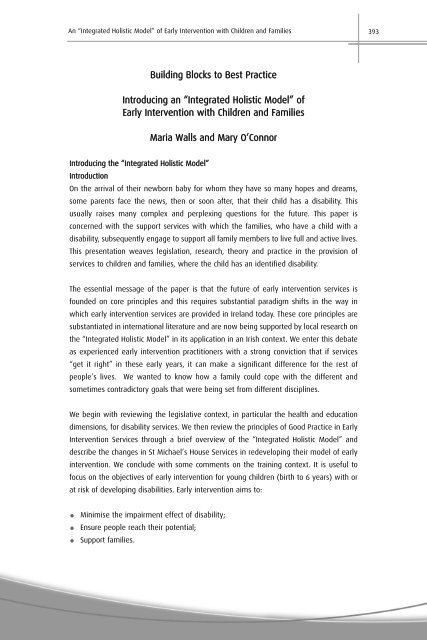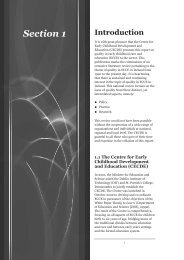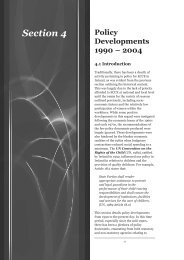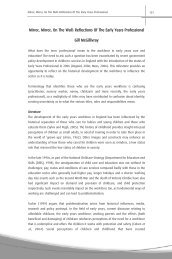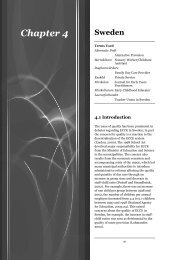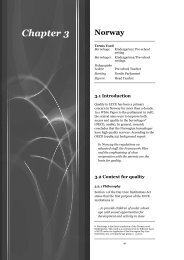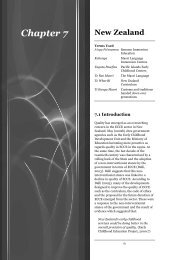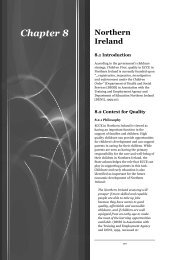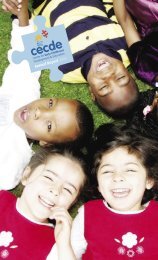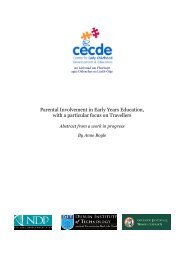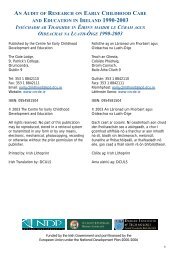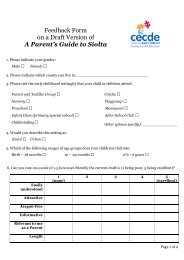Integrated Holistic Model - Centre for Early Childhood Development ...
Integrated Holistic Model - Centre for Early Childhood Development ...
Integrated Holistic Model - Centre for Early Childhood Development ...
You also want an ePaper? Increase the reach of your titles
YUMPU automatically turns print PDFs into web optimized ePapers that Google loves.
An “<strong>Integrated</strong> <strong>Holistic</strong> <strong>Model</strong>” of <strong>Early</strong> Intervention with Children and Families 393Building Blocks to Best PracticeIntroducing an “<strong>Integrated</strong> <strong>Holistic</strong> <strong>Model</strong>” of<strong>Early</strong> Intervention with Children and FamiliesMaria Walls and Mary O’ConnorIntroducing the “<strong>Integrated</strong> <strong>Holistic</strong> <strong>Model</strong>”IntroductionOn the arrival of their newborn baby <strong>for</strong> whom they have so many hopes and dreams,some parents face the news, then or soon after, that their child has a disability. Thisusually raises many complex and perplexing questions <strong>for</strong> the future. This paper isconcerned with the support services with which the families, who have a child with adisability, subsequently engage to support all family members to live full and active lives.This presentation weaves legislation, research, theory and practice in the provision ofservices to children and families, where the child has an identified disability.The essential message of the paper is that the future of early intervention services isfounded on core principles and this requires substantial paradigm shifts in the way inwhich early intervention services are provided in Ireland today. These core principles aresubstantiated in international literature and are now being supported by local research onthe “<strong>Integrated</strong> <strong>Holistic</strong> <strong>Model</strong>” in its application in an Irish context. We enter this debateas experienced early intervention practitioners with a strong conviction that if services“get it right” in these early years, it can make a significant difference <strong>for</strong> the rest ofpeople’s lives. We wanted to know how a family could cope with the different andsometimes contradictory goals that were being set from different disciplines.We begin with reviewing the legislative context, in particular the health and educationdimensions, <strong>for</strong> disability services. We then review the principles of Good Practice in <strong>Early</strong>Intervention Services through a brief overview of the “<strong>Integrated</strong> <strong>Holistic</strong> <strong>Model</strong>” anddescribe the changes in St Michael’s House Services in redeveloping their model of earlyintervention. We conclude with some comments on the training context. It is useful tofocus on the objectives of early intervention <strong>for</strong> young children (birth to 6 years) with orat risk of developing disabilities. <strong>Early</strong> intervention aims to:Minimise the impairment effect of disability;Ensure people reach their potential;Support families.
394Questions of QualityAs stated in the British Government guidelines consultation document <strong>for</strong> birth-to-threeyear olds (2002), early intervention is defined as supporting the child in all aspects ofdevelopment, including:Health Care;Educational and therapeutic input;Supporting the family as needed to maximise emotional development;Providing support that respects cultural and religious views.It is clear from the paper by Glennane et al. (2005) that there is high level of agreementon some of the core principles. Sloper (1999) and Carpenter (1998) identify the followingcommon features of successful services:An holistic approach to assessing and meeting family need;An emphasis on the importance of collaborative relationships with professionals;A consistent, single point of contact;A flexible, individualised needs-led approach;A focus on parent perception of need;The empowerment of parents.ResearchThis paper incorporates the learning from two pieces of research conducted in Ireland bythe two presenters in voluntary organisations providing services to children and adults;one to people with a physical disability, the other a learning disability. This research setsout to explore how to implement new models of early intervention services to childrenand families with a disability. Both methodologies employed qualitative methods withaspects of the action research paradigm, to directly influence the implementation ofservice provision.The Disability ContextThis development in early intervention services within disability services is set within awider context of change in the disability sector. There are currently a number of majordevelopments in policy and legislation:The landmark document, Strategy <strong>for</strong> Equality (Commission on the Status of Peoplewith Disabilities, 1996), signalled the beginning of change and the requirement <strong>for</strong>partnership and consultation with people with disability;The establishment of the National Disability Authority in 2000;The Government Health Strategy, Quality and Fairness (Department of Health andChildren [DHC], 2001), introduced the principle of person centred services and sought
An “<strong>Integrated</strong> <strong>Holistic</strong> <strong>Model</strong>” of <strong>Early</strong> Intervention with Children and Families 395the development of standards in disability services;The Education <strong>for</strong> Persons with Special Educational Needs Act was signed into life inJuly 2004;The Disability Bill launched September 2004 presents the opportunity <strong>for</strong> the mostradical changes to date - however it is still unclear as to the potential impact of thislegislation;The Strategic Review of Disability Services established in 2004 by the DHC followinga commitment sanctioned in Sustaining Progress 2003-2005;The Re<strong>for</strong>m of the Health Services currently underway.Consequently, disability awareness has moved from being a health issue to a matter ofimportance <strong>for</strong> all Government Departments, crossing education, employment, socialwelfare, housing, transport etc. The government has committed to a mainstreamingagenda.The Education <strong>for</strong> Persons with Special Educational Needs Act (2004) impacts specificallyby providing <strong>for</strong> Individual Education Plans <strong>for</strong> children with special education needs. It ispossible to interpret the Act as including all birth to 6 year olds. The National IntellectualDisability Database Report (Barron and Mulvany, 2003) identifies 1,044 children in thebirth to 4 age category and 1,878 in the 5 to 9 age group. The Disability Bill (2004) willprovide <strong>for</strong> a health needs assessment. It is anticipated that these assessments and planswill be incorporated into one plan <strong>for</strong> each child. For many years, confusion has existed inthe provision of services to young children with disability and their families, arising fromthe split responsibility between health and education. The question remains as towhether the a<strong>for</strong>ementioned Bill and Act will resolve these issues.The “<strong>Integrated</strong> <strong>Holistic</strong> <strong>Model</strong>”The “<strong>Integrated</strong> <strong>Holistic</strong> <strong>Model</strong>” describes the key building blocks of effective earlyintervention, based on best practice as reflected in international research.Developing from the work of Bronfenbrenner (1979), a theme that will emerge withinthe conceptual framework is the “rings to change”. These are eight interconnected ringscontaining the key elements of the model. The framework links what happens within themicrocosm of the family who has a young child with a physical disability with themesocosm of the organisation and the macrocosm of society at large.The “<strong>Integrated</strong> <strong>Holistic</strong> <strong>Model</strong>” is founded on the following core values:
396Questions of QualityRights based perspective;Social model;Inclusive environments.Rights Based PerspectiveThe rights based perspective takes seriously the assertion that all persons are born equalwith inalienable rights (Quinn, 2001:2). In the Irish context Baker (1998) quotes the Irishconstitution: “The Republic guarantees … equal rights and equal opportunities to all itscitizens…. cherishing all the citizens of the nation equally.” Yet rights of Irish children andadults with disabilities are weak (Quinn, 2001). However, Ireland has legal obligations ininternational law and policy.Social <strong>Model</strong>A significant shift in thinking in the implementation of the <strong>Integrated</strong> <strong>Holistic</strong> Approach isthe move from the medical to the social model of disability. Quinn (2001:3) states:“According to the social construct idea, people are not born different. Difference is notinherent in a human being. It is socially constructed.”The change from a medical to a social model moves from individual responsibility tosocietal responsibility. Put simply, if I break my leg, it is not my leg which prevents megetting up a step, but the absence of a ramp to facilitate me. Oliver (1993:63) definesthe medical definition of disability “…as individual problem …” The medical modelsupported segregation; the social model focuses on inclusion. The World HealthOrganisation (WHO) recently revised the international classification of disability (ICIDH) toacknowledge inclusion in activity and participation as set out in Table 1 below.Table 1 - ICIDHInternational Classification of Impairment Disability and HandicapOriginal ICIDHRevised ICIDH2impairment to impairmentdisability to activityhandicap to participationInclusive EnvironmentsInclusive settings are the least restrictive environments of choice, in its fullest sense. Theyinclude full access to buildings, support to participate in activities or welcoming and openattitudes.
An “<strong>Integrated</strong> <strong>Holistic</strong> <strong>Model</strong>” of <strong>Early</strong> Intervention with Children and Families 397Implementation of the “<strong>Integrated</strong> <strong>Holistic</strong> <strong>Model</strong>” challenges the provision of centrebasedservices. Inclusion reduces stigma and provides the opportunity <strong>for</strong> the communityto act as a resource <strong>for</strong> the family to support child development.Eight Building Blocks of the “<strong>Integrated</strong> <strong>Holistic</strong> <strong>Model</strong>”On embarking on an exploration of the eight main building blocks of the model, it isimportant to set out their reliance on the essential role of the two cornerstones of Childand Family <strong>Centre</strong>d and the beneficial structure of the Individual Family Service Plan. SeeFigure 1.Figure 1 - Eight Building Blocks of the <strong>Integrated</strong> <strong>Holistic</strong> <strong>Model</strong>OutcomesFocusedApproachImplementingReviewingEvaluationServicescloser tofamiliesChild andFamilyCenteredPartnershipCollaborationInterdisciplinaryTransdisciplinaryTeamsIndividualFamily ServicePlansThe key elements (building blocks) of the “<strong>Integrated</strong> <strong>Holistic</strong> <strong>Model</strong>” are:1 Child and Family centred approach;2 Partnership;3 Collaboration;4 Interdisciplinary/transdisciplinary approach;5 Individual family service plans;6 Bringing services closer to families;7 Implementing, reviewing and evaluation;8 Outcomes focused approach.1. Child and Family <strong>Centre</strong>d ApproachSince the 1970s, the importance of working with families as well as the child withdisability, has been acknowledged. Rosin et al. (1996) defines Family <strong>Centre</strong>d Care as aservice delivery system with families as the focal point, serving as partners and decisionmakersin the early intervention process. This requires an understanding of familysystems. Begun (1996) defines this approach as trans<strong>for</strong>ming, by placing the family at thecentre and viewing the service provider as a collaborator. Families are not just a collectionof individuals but a complex system; it is not just about receiving in<strong>for</strong>mation <strong>for</strong>assessment purposes and <strong>for</strong> parents to provide therapy, but rather the inclusion of thewhole family in the process.
398Questions of QualityBrinker et al. (1994) argue that the simultaneous goals of early intervention are tofacilitate the development of the infant with disabilities and to assist the parents in theiradaptation to their child. Adaptation refers to a process of grieving that helps a familyachieve a com<strong>for</strong>table balance and to promote the growth and development of individualmembers and the system as a whole in adjusting to a member having a disability.Rain<strong>for</strong>th and York-Barr (1997) suggest that it is important <strong>for</strong> therapists to understandthe implications of grieving. Beres<strong>for</strong>d (1995) suggests:“…a good service would involve a holistic, interagency approach …in which the needsof the child as opposed to the impairment are considered…”DePompei and Williams (1994) advocate the need to develop the capacity within thefamily throughout its life cycle.EvidenceIn the research within the physical disability organisation all stakeholders were askedhow would they know that such services were present in Ireland and their repliessuggested:Provision <strong>for</strong> siblings;Home visits;Involvement in all parts of assessment process in defining the issues, and devisingsolutions;Meeting parents together;Timing of visits;Video of intervention <strong>for</strong> father;Key worker.2. Partnership“(Partnership) ….requires abdication of paternalistic approaches to helpingrelationships and adoption of empowerment, participatory involvement andcompetency enhancement approaches to help giving.” (Dunst et al., 1994:211)Rosin et al. (1996) propose that family centred early intervention creates the need tochange how parents and service providers work together. Partnership involves amovement away from the expert model of professionals gathering in<strong>for</strong>mation andmaking decisions about service provision. Dale (1996) proposes the adoption of thenegotiating model whose premise is that parents and professionals have separate butpotentially highly valuable contributions to make.
An “<strong>Integrated</strong> <strong>Holistic</strong> <strong>Model</strong>” of <strong>Early</strong> Intervention with Children and Families 399In organising programmes and consulting on the design of services with families, parentsreport that they feel more equal in these environments. For example if I attend my GP, Iam unlikely to raise many questions about my service. However, if I were to attend aconsultation on GP services, I may have strong suggestions to make. Consulting withparents needs to take place at an individual, family level and service level.3. CollaborationJesien (1996:186) defines collaboration as :“…the sharing of power, in<strong>for</strong>mation, and resources between at least two persons,programs or agencies to facilitate a mutually beneficial activity to further theachievement of a mutually beneficial goal.”Crais (1993) suggests that the key issues in making collaboration successful are to focuson process versus outcome and the extent to which the service is family directed orprofessional directed. The essence of collaboration is choice, involving parity amongparticipants, based on mutual goals, dependent on shared responsibility <strong>for</strong> participationand decision making, sharing resources and accountability <strong>for</strong> outcomes. Rain<strong>for</strong>th andYork-Barr (1997) suggest that collaboration may be described as not directive,authoritarian or prescriptive.EvidenceIn the research all stakeholders were asked how would they know that such services werepresent in Ireland and their replies suggested:Asking parents about the level and nature of their involvement, and where theinvolvement should take place;Using a problem solving <strong>for</strong>mat;Committing resources to enable parent involvement in advisory programmes;Facilitating parent to parent contact;Using evaluation and parent satisfaction surveys;Consulting on the planning and development of services;Family directed service.4. Interdisciplinary / Transdisciplinary TeamsTuchman (1996:120) states that:“The team is the mechanism which makes the heart of the intervention work. Theteam approach recognises that young children with disabilities typically havemultifaceted needs that can be addressed more effectively by a team rather than bya single service provider.”
400Questions of Quality<strong>Model</strong>s of TeamingTuchman (1996) describes multidisciplinary, interdisciplinary and transdisciplinary teams.Teams develop by establishing a shared vision and philosophy, and learning how to worktogether effectively to make decisions, solve problems and carry out responsibilities.Multidisciplinary teamsMultidisciplinary teams share common goals but work independently of one another. Eachmember represent his/her own discipline and uses discipline specific skills. Parentsreceive in<strong>for</strong>mation related to a specific area of development and a plan is drawn upwhich relates to the particular discipline.Interdisciplinary teamsInterdisciplinary teams share common goals and are committed to communicating witheach other and with families with whom they work. There is planned interaction and<strong>for</strong>mal arrangements <strong>for</strong> communication, <strong>for</strong> assessments, planning, and intervention.However, there is also increased parental involvement.Transdisciplinary teamsTransdisciplinary teams share common goals and plan together using a systematic process<strong>for</strong> sharing roles and crossing disciplinary boundaries to maximise communication,interaction and co-operation among members. Decisions are made by consensus andfamily participation is crucial.Tuchman (1996) identified this model as providing the best service to families as theyintegrate the principles of co-ordination and family centred service to a greater extentthan do the others. The most common <strong>for</strong>m of teaming in the Irish disability sectorremains multi disciplinary teams, with some movement towards interdisciplinaryworking.<strong>Integrated</strong> Therapy and Natural EnvironmentsRain<strong>for</strong>th and York-Barr (1997) argue that transdisciplinary models are best placed tosupport natural environment work. <strong>Integrated</strong> Therapy emphasises the provision ofservices within contexts which are considered meaningful or functional <strong>for</strong> an individual.Discussion is needed in Ireland to develop natural environment work by using key peopleand environments in the person’s life.5. Individual Family Service Plan (IFSP)“The guidelines, mandating an Individual Family Service Plan (IFSP) <strong>for</strong> each child andfamily, the identification of the parents’ concerns, priorities, and resources (CPRs),and the focus on increased decision making by parents have prompted early
An “<strong>Integrated</strong> <strong>Holistic</strong> <strong>Model</strong>” of <strong>Early</strong> Intervention with Children and Families 401intervention professionals to discover new and creative ways to engage parents andother caregivers in the early intervention process.” (Crais and Wilson, 1996:125-126).The core focus of US IDEA legislation is on parental involvement and the mechanism <strong>for</strong>ensuring parent-professional collaboration in implementing the IFSP process. Rosin et al.(1996) portray the IFSP process as a promise to families, a way to build trustingrelationships and a vehicle <strong>for</strong> empowerment. In the UK, a system of “statementing” orlegally obliging educational needs is in use. The Education <strong>for</strong> Persons with SpecialEducational Needs Act introduces the Individual Education Plan process in Ireland.6. Bringing Services Closer to FamiliesServices Closer to Families involves changes in the way services are provided. They buildon the principle of inclusive communities. They involve the setting up of outreach servicesand increasing home and community visits.7. Implementing, Reviewing, and EvaluationBauman et al. (1997) state that inadequate levels of programme evaluation are evident.Within the past ten years, there has been a substantial increase in the move to serviceevaluation. Intellectual disability service providers in Ireland have made a significantcommitment to a range of quality assurance models, some with external accreditation.8. Outcomes Focused ApproachThe Outcomes Focused Approach requires a paradigm shift from looking at the servicespeople receive to looking at what goals are achieved. The Council on Quality & Leadership,Personal Outcomes Measures (1995) model has specific outcomes <strong>for</strong> early interventionservices.Paradigm ShiftThe “<strong>Integrated</strong> <strong>Holistic</strong> <strong>Model</strong>” requires paradigm changes in practice. This change issummarised in the following table of the Paradigm Shift Summary. I propose that <strong>for</strong> ateam to work successfully, they must aim to cross all elements of the paradigm.
402Questions of QualityTable 2 - Paradigm Shift SummaryFromCharityPaternalMedical <strong>Model</strong>Disability focusExpertPrescriptiveProfessional drivenSegregatedGroupEducation/TherapyMultidisciplinaryDiscipline focusedStandards<strong>Centre</strong> based Assess.DeficitToRightsEmpoweringSocial modelChild and family centredPartnershipCollaborative consultationConsumer drivenMainstream/InclusiveIndividualWhole lifeInter/transdisciplinaryAge group programme basedOutcomes<strong>Integrated</strong> real environment Assess.Strengths basedFrom Theory to PracticeIn considering the implementation of this model in Ireland, the followingrecommendations were made:Dedicated structure;Leadership and Co-ordination;Understanding Change;Teamwork and Time;Getting Parents involved;Move from uni-dimensional to multi-dimensional approach.To make this complex change effective, it is essential to understand that the “<strong>Integrated</strong><strong>Holistic</strong> <strong>Model</strong>” is a better way of providing services to children and families. The <strong>Model</strong>pulls together different threads that have existed in many services in Ireland, some ofwhich are more developed in the U.S. It is presenting a more complete picture of theintervention which requires the marrying of Irish, and International practice. St MichaelHouse Services show that this is possible, that a service has made significant steps tomove into the model.
An “<strong>Integrated</strong> <strong>Holistic</strong> <strong>Model</strong>” of <strong>Early</strong> Intervention with Children and Families 403Moving from Child <strong>Centre</strong>d to Child and Family <strong>Centre</strong>d Services in <strong>Early</strong> InterventionSt. Michaels’s HouseIn St Michael’s House, the journey of change began <strong>for</strong> us at the end of the 1990s. Amultidisciplinary team provided a range of services to young children with intellectualdisability. We knew that there were gaps in the services due to resource deficits. Weknew that some of the families who used our service were not always happy with us. Webelieved that this was because of resource deficits, but we also had an underlying feelingthat there was something else going on. So we set out to discover what the staff and thefamilies who used the service thought of the current services, and what they thoughtshould be different. At the same time, we researched the literature <strong>for</strong> examples ofmodels of service in Ireland and in other countries.Through a two-year process of research and consultation, we arrived at the point wherewe understood that, in order to meet the needs of the children and families we serve, wehad to make some radical changes to our model of service. It is fair to say that the changewe faced was trans<strong>for</strong>mational. We will describe the theoretical basis of the change inthe model of service and describe how our new model of service operates.Who is the User of the Service?Wasik (1990) conceptualises the user of services in the following way:Table 3Older modelsChildIndividualEncapsulatedHandicappedNewer modelsFamilyFamily SystemEcologicalUniversalThis shift from older models of service to newer models reflects our changingunderstanding of children, of families and of disability. Ecological theories of humandevelopment highlight the inadvisability of viewing children’s development in contextthat is divorced from the child’s family and wider environment. Our understanding ofdisability has shifted from a deficit-oriented model to a model that identifies thestrengths and needs of all children. The family becomes the focus of intervention, notbecause the family is per se in need of help because they have a disabled child, butbecause families are where children grow and learn and because childhood disability mayplace additional strain on families.
404Questions of QualityThe Role of the Helper in Newer ServicesJust as our view of the people who use the service changed, our view of ourselves asservice providers also has to shift.Table 4 - The Role of the HelperOlder modelsExpertProblem solverDecision makerNewer modelsCollaboratorFacilitatorNegotiatorIn older models of service the professionals were seen as having all the expertise and allthe solutions to any difficulties that might face families. Professionals were considered toknow what was best <strong>for</strong> children and <strong>for</strong> families. In newer models of service, familiesare seen as the experts in relation to their own child. Certainly, professionals haveexpertise in particular areas and that expertise, taken together with the family’sknowledge of their own child, can be shared so that everyone can work collaborativelywith families to support them to make decisions that are right <strong>for</strong> them. Newer modelsof working are essentially about empowering families. Families who have a child with adisability face many years of decision-making. <strong>Early</strong> intervention services that do notempower families create dependencies that inevitably cause difficulties <strong>for</strong> the family andchild when those services change, as they surely will, as the child grows.Individual PlanningIn newer models of early intervention services, supports are provided based on identifiedneed <strong>for</strong> both child and family. Parents are more likely to identify “playing with toys” asa goal <strong>for</strong> their child than to identify that their child needs to be optimally positioned touse their hands, develop increased range of motion, acquire the concept of means-endand develop hand-eye co-ordination. Plans to support development need to centre onthe realities of children’s lives, not on developmental domains and deficit models.Families may have needs arising from their child’s disability. Assisting a family to retainor rein<strong>for</strong>ce the family’s connection to a natural support network of family or friends is alegitimate goal of early intervention.Using OutcomesA framework such as Outcomes <strong>for</strong> Families with Young Children (The Council on Quality& Leadership, 1995) supports services to make the transition from old to new ways ofworking. Instead of focusing on inputs (number or type of staff, number of assessmentscarried out, number of treatment sessions) or processes (the way the work is organised),the service focuses on Outcomes.
An “<strong>Integrated</strong> <strong>Holistic</strong> <strong>Model</strong>” of <strong>Early</strong> Intervention with Children and Families 405Some Outcomes <strong>for</strong> families with young children are:Families are in<strong>for</strong>med;Families choose child development goals;Families choose their goals;Families choose services and supports;Children attain developmental milestones.Services organised to support Outcomes emphasise in<strong>for</strong>mation giving, key-working andthe co-ordination of services, services based on family identified need and collaborative/transdisciplinary work.Key WorkingSloper (1999), reviewing services in the United Kingdom, states that the absence of keyworkers causes provision that is “…piecemeal and service- rather than needs-led.”Families incur additional stress when they have to deal with multiple unconnected, orworse, contradictory interventions from different professionals. A keyworker or service coordinator,who knows the family well, assists the family to pull all the pieces of serviceprovision together into a connected whole that fits with their individual family needs.Transdisciplinary WorkHow professionals work together is a major factor affecting the co-ordination of servicesto families. In the past, multidisciplinary teams of specialists – doctors, social workers,speech and language therapists, occupational therapists, physiotherapists, teachers andpsychologists all worked separately, causing the problems of fragmentation describedabove. With the advent of interdisciplinary teams, where in<strong>for</strong>mation is shared, all teammembers can facilitate goals.There is growing interest in transdisciplinary teams. In this type of team the roles of theteam members are less differentiated. Members share skills with each other and one ortwo members work primarily with the family, calling on the more expert skills of theircolleagues as required. The concept is particularly applicable to <strong>Early</strong> Intervention teamsprecisely because it is a powerful tool <strong>for</strong> dealing with fragmentation.Guralnick (1997) whose book “The Effectiveness of <strong>Early</strong> Intervention” is the seminalwork summarising the ‘state of the art’ of <strong>Early</strong> Intervention describes the hallmarks ofeffective <strong>Early</strong> Intervention services as follows. Effective services should:<strong>Centre</strong> on the needs of families;Be based in the community;
406Questions of QualityBe able to thoroughly and efficiently integrate the contributions of multipledisciplines;Have the capacity to plan and co-ordinate supports and services from multipledisciplines.This statement does not ignore the need <strong>for</strong> appropriate models of curriculum and servicecontent. It takes <strong>for</strong> granted that effective services must have an effective contentcomponent (while acknowledging that we still face many challenges in developing ourknowledge base about what really works in <strong>Early</strong> Intervention). Rather, it prompts us tounderstand that many of the challenges we face lie in the “how” not in the “what”.Training <strong>for</strong> ProfessionalsIn Ireland there is no specific training <strong>for</strong> professionals to work with young children withdisability and their families. Many courses (therapy professions, learning disabilitynursing, some childcare and education courses) contain short modules focused on theneeds of children with disability in specific areas. However, there is a need <strong>for</strong> training<strong>for</strong> all professionals that clearly articulates models of early intervention and equips stafffrom a range of disciplines to work effectively with families with young children with adisability.In terms of how professionals work together there is a need <strong>for</strong> training courses toencompass within them specific approaches to teamwork and to skill sharingtransdisciplinary work. There is a need <strong>for</strong> the relevant undergraduate courses to focuson the importance of co-ordination and integration. Common training inputs are one wayof achieving this. It might also be useful to look at establishing a post-graduate diplomatype course that supports professionals from a variety of backgrounds to learn theadditional skills they require to become skilled early interventionists.We in St. Michaels’ House feel at this stage we have made significant progress, but thework is not without its challenges. Shonkoff and Meisels (1990) state:“The progressive and inevitable ambiguity of disciplinary boundaries represents oneof the central challenges facing the field of early childhood intervention”This is as true in 2004 as it was in 1990.
An “<strong>Integrated</strong> <strong>Holistic</strong> <strong>Model</strong>” of <strong>Early</strong> Intervention with Children and Families 407ReferencesBaker, J. (1998). Equality. Equality Research Studies. UCD.Barron, S. and Mulvaney, F. (2003). National Intellectual Disability Database CommitteeAnnual Report. Dublin: Health Research Board.Bauman, L., Drotar, D., Leventhal, J. Perrin, E. and Pless, B. (1997). “A Review ofPsychosocial Interventions <strong>for</strong> Children with Chronic Health Conditions.” Pediatrics, Volume100, No. 2.Begun, A. (1996) (in) Rosin, P., Whitehead, A., Tuchman, L., Jesien, G., Begun, A. andIrwin, L. (1996). Partnerships in Family <strong>Centre</strong>d Care - A Guide to Collaborative <strong>Early</strong>Intervention. Maryland: Brookes Publishing Co.Beres<strong>for</strong>d, B. (1995). Expert Opinions: A National Survey of Parents Caring <strong>for</strong> a SeverelyDisabled Child. Bristol: The Policy Press.Bronfenbrenner, U. (1979). The Ecology of Human <strong>Development</strong>: Experiments by Natureand Design. Cambridge, MA: Harvard University Press.Brinker, R., Seifer, R. and Sameroff, A. (1994). Relations Among Maternal Stress, Cognitive<strong>Development</strong>, and <strong>Early</strong> intervention in Middle-and Low SES infants with <strong>Development</strong>alDisabilities. American Journal of Mental Retardation, Volume 98, No. 4, pp. 463-480.Carpenter, B. (1998). Working with Families in <strong>Early</strong> Intervention. Paper given to Eurlyaid4th European Symposium.Commission on the Status of People with Disabilities (1996). A Strategy <strong>for</strong> Equality:Report of the Commission on the Status of People with Disabilities. Report Commissionedby the Department of Equality and Law Re<strong>for</strong>m. Dublin: The Stationery Office.Council on Quality and Leadership in Supports <strong>for</strong> People with Disabilities (1995). OutcomeMeasures <strong>for</strong> <strong>Early</strong> <strong>Childhood</strong> Intervention Services. Towson: The Council.Crais, E. (1993). Families and Professionals as Collaborators in Assessment, Topics inLanguage Disorders, Volume 14, No. 1, pp. 29-40.Crais, E. and Wilson, L. (1996). The Role of Parents in Child Assessment: Self Evaluation byPracticing Professionals. The Transdisciplinary Journal, Volume 6, No. 2, pp. 125-143.
408Questions of QualityDepartment of Education and Science (2004) The Education <strong>for</strong> Persons with SpecialEducational Needs Act. Dublin: The Stationary OfficeDepartment of Health and Children (2001). Quality and Fairness – A Health System <strong>for</strong> You– Health Strategy. Dublin: The Stationery Office.Department of Health, Department <strong>for</strong> Education and Skills (2002). Together from theStart – Practical Guidance <strong>for</strong> Professionals Working with Disabled Children and theirFamilies. United Kingdom: Department of Health, Department <strong>for</strong> Education and Skills.Dale, N. (1996). Working with Families of Children with Special Needs. London: Routledge.DePompei, R. and Williams, J. (1994). Working with Families after TBI: A Family <strong>Centre</strong>dApproach. Topics in Language Disorders, Volume 15, No. 1, pp. 68-81.Duffy, M. (1993). The Voluntary Sector and the Personal Social Services. Administration,Volume 41, No. 3, pp. 323-344.Dunst, C., Trivette, C. and Johanson C. (1994). Parent Professional Collaboration andPartnerships. (in) Dunst, C. Trivette, C. and Deal, A. (Eds.). Supporting and StrengtheningFamilies: Vol. 1. Methods Strategies and Practices, Cambridge, MA: Brookline Books. pp.197-211.Glenanne, R., Morrison, T., Oswell, J. and Timothy, A. (2005) Interdisciplinary TeamAssessment – CRC Style (in) Schonfeld, H., O’Brien, S. & Walsh, T. (Eds.). Questions ofQuality - Proceedings of a Conference on Defining, Assessing and Supporting Quality in<strong>Early</strong> <strong>Childhood</strong> Care and Education. Dublin: <strong>Centre</strong> <strong>for</strong> <strong>Early</strong> <strong>Childhood</strong> <strong>Development</strong> &Education.Government of Ireland (2004). The Disabilities Bill. Dublin: The Stationary Office.Guralnick, M. (Ed.) (1997). The Effectiveness of <strong>Early</strong> Intervention. Baltimore: Paul BrookesPublishing.International Classification of Impairment Disability and Handicap (1999). Available at:http://www.who.ch/icidh. [Accessed: 30th September 2004].Jesien, G. (1996). (in) Rosin, P., Whitehead, A., Tuchman, L., Jesien, G., Begun, A. andIrwin, L. (1996). Partnerships in Family <strong>Centre</strong>d Care - A Guide to Collaborative <strong>Early</strong>Intervention. Maryland: Brookes.
An “<strong>Integrated</strong> <strong>Holistic</strong> <strong>Model</strong>” of <strong>Early</strong> Intervention with Children and Families 409Oliver, M. (1993). Social Work and Disabled People. London: Penguin Press.Quinn, G. (2001). The Evolution of the Rights Based Approach to Disability: Internationaland Irish Perspectives. (in) Access West Directory, A Guide to Services, Supports and aRights Based Perspective <strong>for</strong> People with a Physical and Sensory Disability in Galway,Mayo and Roscommon. Available from: www.accesswest.ieRain<strong>for</strong>th, B. and York-Barr, J. (1997). Collaborative Teams <strong>for</strong> Students with SevereDisabilities. Maryland: Brookes.Rosin, P., Whitehead, A., Tuchman, L., Jesien, G., Begun, A. and Irwin, L. (1996).Partnerships in Family <strong>Centre</strong>d Care - A Guide to Collaborative <strong>Early</strong> Intervention.Maryland: Brookes.Sloper, P. (1999). <strong>Model</strong>s of Service Support <strong>for</strong> Parents of Disabled Children. What do weKnow? What do we Need to Know? Child: Care, Health and <strong>Development</strong>, Volume 25, No.2Sloper, P. and Turner, S. (1992). Service Needs of Families of Children with Severe PhysicalDisability. Child: Care, Health and <strong>Development</strong>, Volume 18, pp. 259-282.Tuchman, L. (1996). (in) Rosin, P., Whitehead, A., Tuchman, L., Jesien, G., Begun, A. andIrwin, L. (1996). Partnerships in Family <strong>Centre</strong>d Care - A Guide to Collaborative <strong>Early</strong>Intervention. Maryland: Brookes.Shonkoff, J. and Meisels, S. (1990). Handbook of <strong>Early</strong> <strong>Childhood</strong> Intervention. Cambridge:Cambridge University Press.“Strategy <strong>for</strong> Equality” Report of the Commission on the Status of People with Disabilities,(1996). A Guide to Services, Supports and a Rights Based Perspective <strong>for</strong> People with aPhysical and Sensory Disability in Galway, Mayo and Roscommon.Wasik, B. and Bryant D. (1990). Home Visiting. Procedures <strong>for</strong> Helping Families. London:Sage Publications.


